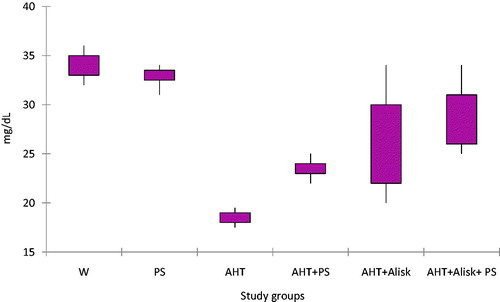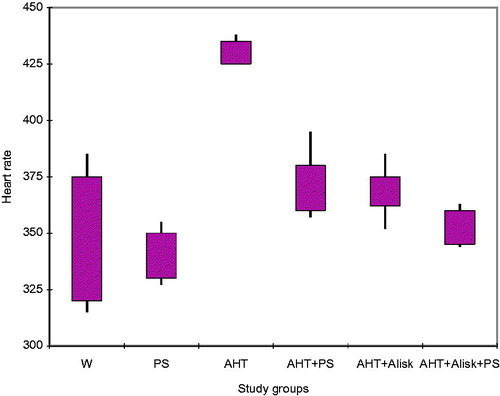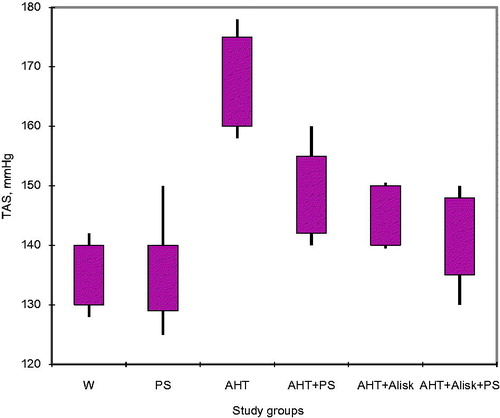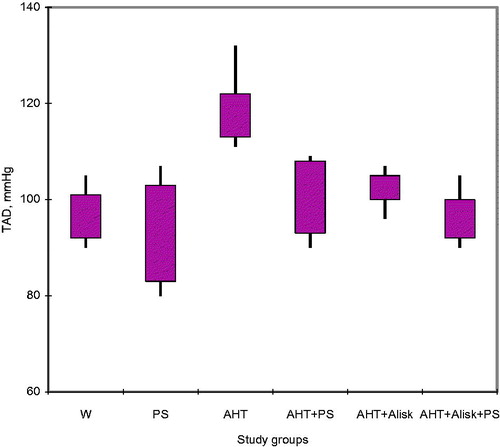Abstract
Context: The health effects of Sambucus nigra L. (Caprifoliaceae) could be due to polyphenols whose modes of action differ from the traditional one proposed for exogenous antioxidants.
Objective: The study emphasizes the effects of the association between the renin inhibitor and the polyphenolic extract on biochemical parameters and systolic (TAS) and diastolic (TAD) blood pressure within an L NAME-induced experimental model of arterial hypertension (AHT).
Materials and methods: The polyphenols are extracted with ethanol from isolated and purified vegetable material represented by the mature fruit of the S. nigra with a dosage of 0.046 g/kg body weight (PS), every 2 days, for 8 weeks. The dose represents 1/20 of LD50. The Wistar white rat blood pressure values were recorded using a CODA™ system, which uses a non-invasive blood pressure measuring method.
Results and discussion: The total antioxidant capacity levels were significantly decreased (p < 0.001) in AHT group as compared to the rats in the AHT + PS group. A combination of a renin inhibitor (Aliskiren) and polyphenolic extract generated a superior antioxidant effect compared to administering the two separately. Both TAS and TAD in rats with drug-induced hypertension were reduced by polyphenolic extract. The homogeneous values of TAS record a significant decrease (p < 0.001) of the average values in AHT + PS group or AHT + Aliskiren group.
Conclusion: The combination of two different classes of substances, namely, renin inhibitors and natural polyphenol extracts, reduces arterial pressure and also might reduce the side effects of the major classes of antihypertensive agents and improve the quality of live.
Introduction
Polyphenols (flavonoids, lignans, stilbenes, etc.) are the most diverse group of phytochemicals distributed in vegetables, fruits, olive oil and wine, and exhibit wide range of protective roles such as hypolipidemic, antioxidative, antiproliferative and anti-inflammatory effects to reduce the onset of disease progression (Liu Citation2003; George et al. Citation2009).
Among the great family of polyphenols, flavonoids play an important role. Bioflavonoids are biologically active compounds that, once inside the human body, determine a positive biologic response (Mennen et al. Citation2004). Bioflavonoids are recommended as supplement in preventing and treating those deficiencies that involve capillary fragility and permeability (Yao et al. Citation2004).
Several epidemiological studies (Dauchet et al. Citation2005; Bayard et al. Citation2007) suggest that regular consumption of foods and beverages rich in polyphenols is associated with a reduction in the risk of a range of pathological conditions, such as arterial hypertension (AHT), coronary heart disease, stroke, diabetes mellitus and cancer. Co-active compounds identified in the fresh berries of Sambucus nigra L. (Caprifoliaceae) (Elderberry) known as European elder include proteins and several vitamins (e.g., vitamins C, folic acid and pantothenic acid) (Sidor & Gramza-Michałowska Citation2015). This fruit contains many primary metabolites, as sugars and organic acids, and secondary metabolites, as flavonoids (kaempferol, astragalin, quercetin, rutin, isoquercetin, hyperoside) (up to 3.0%), triterpenes (about 1%), sterols (about 1%), phenolic acids (about 3%) and essential oil (up to 0.15%) (Ghosh & Scheepens Citation2009; Cunha et al. Citation2016).
The renin–angiotensin–aldosterone system (RAAS) plays a key role in the regulation of blood pressure and volume homeostasis. The renin inhibitors (Aliskiren) could be an alternative of the angiotensin-converting enzyme inhibitors (ACEI) or the angiotensin receptor blockers (ARB), in treating AHT and it could also accomplish a multi-protection of the organs (heart, kidney, brain) (Gradman et al. Citation2005). Since ACEI and ARB increase the level of plasma renin, Aliskiren combination can be beneficial because it reduces plasma renin activity (Allikmets Citation2007).
The purpose of the study was to emphasize the effects of the association between the renin inhibitor and the S. nigra extract on biochemical parameters and heart rate, systolic and diastolic blood pressure.
Materials and methods
Ripe berries of S. nigra were shade-dried at room temperature for 1 week. Dried berries (100 g) were chopped into small pieces and extracted with 3 × 700 mL ethanol using a magnetic stirrer (FALC F30ST), each time for 3 h. The combined extracts were taken to dryness by evaporation under reduced pressure (BÜCHI R-210 rotavapor, BÜCHI V-850 vacuum controller, BÜCHI V-700 vacuum pump). Total phenolics quantification was performed by Folin-Ciocalteu method. The absorbance was measured at 765 nm after 2 h of incubation at room temperature. A calibration curve was plotted using gallic acid as standard. The amount of total phenolic content was expressed as gallic acid equivalents (GAE)/100 g extract. The absorbencies of all the solutions were determined by using a V-550 Able Jasco UV-VIS spectrophotometer. The result is the mean of triplicates ± standard deviation. The total content of polyphenols was 7.63 ± 0.12 mg GAE/100 g from S. nigra extract. The experiment used active therapeutic doses, well-determined fractions of LD50 on an experimental model of AHT. Fractions of LD50 are doses representing 1/5, 1/10, 1/20, 1/40 of LD50. The dose representing 1/20 of LD50 was chosen, as it is the smallest dose that determined the pharmacodynamic effect that is being researched, without producing significant toxic effects. S-Sambunigrin contains hydrogen cyanide (HCN), which is toxic (3 to 17 mg HCN/100 g fresh weight in leaf and 3 mg HCN/100 g of fruit) (www.ema.europa.eu, Citation2013). Elderberry extracts used in our experiment are generally without side effects when taken in the suggested dosages.
The research was performed on Wistar white rats, with an average weight of 250–280 g, which were divided into 6 groups of 12, namely: W Group – control, normal animals, that did not receive natural polyphenols; PS Group – animals that were administered polyphenols under the form of solution, from the extract obtained from the S. nigra fruit, with a dosage of 0.046 g/kg body, p.o. (by tube feeding), at every 2 days, for 8 weeks. The dry polyphenol extract was diluted in DMSO, 100 mL polyphenolic solution containing 840 mg natural polyphenols, 95 mL distilled water and 5 mL DMSO; AHT Group – animals which were administered N(G)-nitro-l-arginine-methyl ester (L-NAME) 40 mg/kg body/day, i.p., at every 2 days, for 8 weeks; AHT + PS Group – animals which were administered polyphenols in the dosage mentioned p.o. at every 2 days, concomitantly with L-NAME, for 8 weeks; AHT + Alisk Group – animals with AHT induced by L-NAME, that were given Aliskiren 30 mg/kg body/day, administered s.c. for 8 weeks; AHT + Alisk + PS Group – animals with AHT that were given Aliskiren and polyphenols in the above-mentioned dosage, for 8 weeks.
The in vivo experiments, on experimental animal sample, were carried out in specially equipped premises, where conditions of habitat in accordance with standard norms were created. Between experiments, the rats were kept in individual cages and were given food and water. A 12-h light/dark cycles was employed.
The experiments on murine model complied with the ethical norms in experimental research, yet also with the terms enforced by the Iasi ‘Grigore T. Popa’ University of Medicine and Pharmacy Commission of Bioethics. At the same time, the EU norms concerning lab rats were taken into consideration (the Directive of the European Council Committee 86/609/EEC).
For the extracellular response the total antioxidant capacity (TAC) was determined by using a RANDOX kit for manual use by Randox Laboratories Ltd. The major advantage of this test is to measure the antioxidant capacity of all antioxidants in a biological sample and not just the antioxidant capacity of a single compound. The method is based on formation of the ABTS•+ cation [2,2′-azinobis (3-ethylbenzothiazoline-6-sulphonic acid)] and its scavenging by antioxidant sample constituents (e.g. serum or food) measured by spectrophotometry (decay of green/blue chromophore absorbance is inversely associated with antioxidant sample content and the control antioxidant is Trolox, a hydrophilic vitamin E analogue).
Ceruloplasmin determination was performed on an EOS BRAVO automatic analyser. Uric acid determination was carried out by means of Siedel’s modified colorimetric method. The exploration of the lipid profile included the measurement by photocolorimetry, in the serum obtained after separation, of high-density lipoproteins (HDLc) (Lopes-Virella Citation1977), for all the animals included in the experiment.
The rat blood pressure values were recorded using a CODA™ system purchased from Kent Scientific Corporation (Torrington, CT), which uses a non-invasive blood pressure measuring method. It records the blood volume–pressure by a band attached to the tail, homologated by Bland-Altman testing designed to reveal conformity with an invasive method (radiotelemetry), which enjoys proven accuracy, yet it is difficult to use in our study. The method is also recommended by the AHA in its blood pressure measuring guide for laboratory animals. The actual experiment consists of performing at least six blood pressure measurements in each laboratory animal, data collection by means of the CODA™ software and subsequent data processing.
Statistical data interpretation
All the data are shown as mean value ± standard error of the mean (SEM). In order to assess the normal distribution of the groups, Shapiro–Wilk test was performed. Statistical data interpretation considered the corresponding differences for a given significance threshold: p > 0.05, statistically insignificant; p < 0.05, statistically significant; p < 0.01, strong statistical significance; p < 0.001, very strong statistical significance.
Results
The TAC levels were significantly decreased (p < 0.001) in AHT group (1.31 ± 0.16 mmol/L) as compared to the rats in the W (1.55 ± 0.29 mmol/L) and AHT + PS (1.53 ± 0.27 mmol/L) groups. As expected, severe oxidative stress disturbs the antioxidant balance by generating reactive species and decreasing the TAC in the extracellular space. There are similar TAC values in group W and group PS (1.58 ± 0.31 mmol/L) and the differences between the AHT and AHT + PS groups are statistically significant (p < 0.01).
The highest average values of HDLc can be found in W group, very significantly higher (p < 0.001) compared to the AHT group. PS group has average values of HDLc significantly higher (p < 0.001) than those recorded in the AHT, AHT + PS and AHT + Alisk groups. The lowest average values are noticed for the rats in AHT group (). Supplementing the diet with S. nigra determines average values of HDLc close to those recorded in the W group. Significant correlations of the individual values of HDLc with blood pressure have been met only in the groups: AHT + Alisk + PS with systolic blood pressure values (TAS) a weak indirect correlation (r = −0.11) (); AHT + Alisk + PS with diastolic blood pressure values (TAD) a moderate indirect correlation (r = −0.50).
Figure 2. Correlation of HDLc with TAS in AHT + PS and AHT + Alisk + PS groups. Group AHT + Alisk + PS shows a weak, indirect correlation between HDLc with TAS and a moderate indirect correlation between HDLc with TAD. TAS: systolic blood pressure; TAD: diastolic blood pressure.
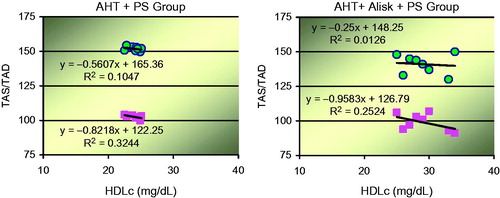
The lowest average values of the ceruloplasmin have been recorded in the AHT group. The highest average values of the ceruloplasmin have been recorded in the W group and in the groups treated with S. nigra. Administration of S. nigra led to similar average values to those found in the W group, which suggests it is the most efficient administration.
The highest average values of the uric acid have been recorded in AHT group, significantly higher than in the other groups. The lowest average values of the uric acid have been recorded in the groups treated with S. nigra and in the W group, significantly lower than those registered in the other researched groups. The statistical processing confirms the homogeneity of the uric acid average values in the groups treated with S. nigra no matter of the association, or not, with AHT.
The highest average values of heart rate were recorded in the AHT group, significantly higher than in other investigated groups. At the significant limit of 95%, the average values of the heart rate in AHT, AHT + PS, AHT + Alisk groups were significantly higher compared to those recorded in W and PS group (). AHT + Alisk + PS group has average values that are significantly lower than the AHT group. To be noted that in groups with AHT the association with Aliskiren and/or polyphenols reduces the heart rate. In the PS group, the average values of heart rate are comparable to those recorded in the W group.
The highest average values of TAS can be found in the AHT group, presenting strong differences, statistically significant compared to other investigated groups. Depending on the investigated group, the homogeneous values of TAS record a significant decrease (p < 0.001) of the average values in AHT + PS group or AHT + Alisk group (). The highest TAD can be found in the AHT group, significantly higher (p < 0.001) than other analysed groups. The PS and AHT + Alisk + PS groups has average values of TAD comparable to those recorded in the W group ().
Discussion
The role of antioxidant nutrients in fighting against oxidative stress is well-established in several diseases including cardiovascular and neurological pathologies (Ferrari & Torres Citation2003). Various epidemiological studies have shown an inverse association between the consumption of polyphenols or polyphenol-rich foods and the risk of cardiovascular diseases (Bell & Gochenaur Citation2006; Pascual-Teresa & Sanchez-Ballesta Citation2008). In this sense, researchers had materially proved that following consumption of diets rich in fruits and vegetables there was an increase in serum TAC (Cao et al. Citation1998).
In this experimental model, all groups were put on the same diet. The reduction in antioxidant mechanisms can be neutralized through natural polyphenol compounds of S. nigra, which will maintain TAC to levels capable of neutralizing ROS effects. The TAC evaluation, used with other oxidative stress and antioxidant defense biomarkers, constitutes the first step in search for a healthy body status.
The beneficial antiradicalar effect of ceruloplasmin is suggested by the fact that all groups present higher average values of ceruloplasmin compared to the hypertensive group. Through stimulating activity of ceruloplasmin, the polyphenols effect is favourable, proving its additional antioxidant role. Moreover, low ceruloplasmin values were associated with low HDLc values and increased heart rate.
The ceruloplasmin and uric acid were determined as non-specific oxidative stress markers. Uric acid acts as a scavenger of free radicals due to covalent bonds that can be set with singlet oxygen. On animal testing, hyperuricemia predisposes to hypertension through various mechanisms such as endothelial dysfunction, inflammation and vascular changes in the renal microcirculation, activation of the RAAS system (Manach et al. Citation2004; Schroeter et al. Citation2010).
Phytochemicals like curcumin, resveratrol, epigallocatechin-3-gallate and isothiocyanates share common properties and play an important role to activate the phase II detoxifying and antioxidant enzymes like heme oxygenase-1 (HO-1), glutathione-peroxidase and glutathione-S-transferase by targeting the common transcription factor Nrf2 [nuclear factor (erythroid derived 2) related factor] (Liby et al. Citation2007; Tosetti et al. Citation2009).
The redox-sensitive transcription factor Nrf2 plays an important role in regulating induction of phase II detoxifying or antioxidant enzymes (HO-1, SOD, etc.), which result in cellular defense against oxidative stress and exert cytoprotective mechanism. A cytoskeleton binding protein called Kelch-like erythroid CNC homologue (ECH)- associated protein 1 (Keap1) binds to Nrf2 regulating its translocation to the nucleus or its activation (Lee-Hilz et al. Citation2006). Following nuclear translocation, Nrf2 binds not only to the specific consensus cis-element called antioxidative responsive element (ARE) or electrophile response element (Na & Surh Citation2008) present in the promoter region of genes encoding many antioxidant enzymes, but also to other trans-acting factors such as small Maf-F/G/K as well as the coactivators of ARE including cAMP response element binding protein (CREB-binding protein or CBP), p300 that can coordinately regulate the ARE-driven antioxidant gene transcription (Dhakshinamoorthy & Jaiswal Citation2000; Shen et al. Citation2004).
Endothelial dysfunction determines changes in cellular redox characteristics. Starting from these premises and from previous studies that have discussed the potential antioxidant extract of S. nigra is proved that incorporation of anthocyanins from these fruits into endothelial cells causes protective effect against oxidative stress (Skoczynska et al. Citation2007).
Association within the inhibitor of renin hypertensive group and separate polyphenols reveal an improvement in mean systolic values of hypertension compared with values obtained in the group that received only Aliskiren. Similar data were obtained for diastolic component of hypertension.
The key question is whether this polyphenolic extract can be used as both preventive and acute therapeutic agents in the treatment of cardiovascular disease. In a preventive approach, S. nigra may lower blood pressure and increased HDLc. Acutely, polyphenols inhibit oxidative stress. Due to the pleiotropic properties of the polyphenols and their potential synergies of action on vascular endothelium, they appear to be good candidates for both the prevention and treatment of cardiovascular diseases.
The use of the direct renin inhibitor in the therapy combined with polyphenolic extract of S. nigra ensures an increased protection and improves the results in comparison with the mono-therapy. The combined inhibition of RAAS may allow the use of smaller doses of each component in order to obtain a more efficient and more durable suppression of RAAS, and probably less adverse effects.
Future studies are required to understand on the mechanisms of the in vivo effects of polyphenolic extract. Additional aspects about bioactivity, absorption and stability of dietary polyphenols with respect to modulation arterial pressure by renin inhibitors are also important areas of further research.
Conclusions
Both systolic and diastolic arterial pressure in rats with drug-induced hypertension were reduced by polyphenolic extract from S. nigra. When polyphenols are associated with renin inhibitor, this occurrence is further enhanced. The polyphenolic extract has both an antioxidant and hypolipemiant effect. In order to form strategies for the intervention and prevention of cardiovascular diseases, an understanding of the basic molecular mechanisms by prophylactic agents is required.
Disclosure statement
The authors declare that they have no competing interests.
References
- Allikmets K. 2007. Aliskiren – an orally active renin inhibitor. Review of pharmacology, pharmacodynamics, kinetics, and clinical potential in the treatment of hypertension. Vasc Health Risk Manag. 3:809–815.
- Bayard V, Chamorro F, Motta J, Hollenberg NK. 2007. Does flavanol intake influence mortality from nitric oxide-dependent processes? Ischemic heart disease, stroke, diabetes mellitus, and cancer in Panama. Int J Med Sci. 4:53–58.
- Bell DR, Gochenaur K. 2006. Direct vasoactive and vasoprotective properties of anthocyanin-rich extracts. J Appl Physiol. 100:1164–1170.
- Cao G, Booth S, Sadowsky JA, Prior RL. 1998. Increases in human plasma antioxidant capacity after consumption of control diets high in fruit and vegetables. Am J Clin Nutr. 68:1081–1087.
- Cunha S, Meireles D, Machado J. 2016. Sambucus nigra – a promising natural source for human health. Exp Pathol Health Sci. 8:59–66.
- Dauchet L, Amouyet P, Dallongeville J. 2005. Fruit and vegetable consumption and risk of stroke: a meta-analysis of cohort studies. Neurology. 65:1193–1197.
- Dhakshinamoorthy S, Jaiswal AK. 2000. Small Maf (MafG and MafK) proteins negatively regulate antioxidant response element-mediated expression and antioxidant induction of the NAD(P)H:quinone oxidoreductase 1 gene. J Biol Chem. 275:40134–40141.
- EMA (2013). Assessment report on Sambucus nigra L., fructus [Internet]. EMA/HMPC/44208/2012, 2-26; [cited 2016 Jul 3]. Available from: www.ema.europa.eu.
- Ferrari CKB, Torres EAFS. 2003. Biochemical pharmacology of functional foods and prevention of chronic diseases of aging. Biomed Pharmacother. 57:251–260.
- George TW, Niwat C, Waroonphan S, Gordon MH, Lovegrove JA. 2009. Effects of chronic and acute consumption of fruit- and vegetable-puree-based drinks on vasodilation, risk factors for CVD and the response as a result of the eNOS G298T polymorphism. Proc Nutr Soc. 68:148–161.
- Ghosh D, Scheepens A. 2009. Vascular action of polyphenols. Mol Nutr Food Res. 53:322–331.
- Gradman AH, Schmieder RE, Lins RL, Nussberger J, Chiang Y, Bedigian MP. 2005. Aliskiren, a novel orally effective renin inhibitor, provides dose-dependent antihypertensive efficacy and placebo-like tolerability in hypertensive patients. Circulation. 111:1012–1018.
- Lee-Hilz YY, Boerboom AM, Westphal AH, van Berkel WJH, Aarts JMM, Rietjens IMC. 2006. Pro-oxidant activity of flavonoids induces EpRE mediated gene expression. Chem Res Toxicol. 19:1499–1505.
- Liby KT, Yore MM, Sporn MB. 2007. Triterpenoids and rexinoids as multifunctional agents for the prevention and treatment of cancer. Nat Rev Cancer. 7:357–369.
- Liu RH. 2003. Health benefits of fruit and vegetables are from additive and synergistic combinations of phytochemicals. Am J Clin Nutr. 78:517S–520S.
- Lopes-Virella MF, Stone P, Ellis S, Colwell JA. 1977. Cholesterol determination in high-density lipoproteins separated by three different methods. Clin Chem. 23:882–884.
- Manach C, Scalbert A, Morand C, Rémésy C, Jiménez L. 2004. Polyphenols: food sources and bioavailability. Am J Clin Nutr. 79:727–747.
- Mennen LI, Sapinho D, De Bree A. 2004. Consumption of foods rich in flavonoids is related to a decreased cardiovascular risk in apparently healthy French women. J Nutr. 134:923–926.
- Na HK, Surh YJ. 2008. Modulation of Nrf2-mediated antioxidant and detoxifying enzyme induction by the green tea polyphenol EGCG. Food Chem Toxicol. 46:1271–1278.
- Pascual-Teresa S, Sanchez-Ballesta MT. 2008. Anthocyanins: from plant to health. Phytochem Rev. 7:281–299.
- Schroeter H, Heiss C, Spencer JPE, Keen CL, Lupton JR, Schmitz HH. 2010. Recommending flavanols and procyanidins for cardiovascular health: current knowledge and future needs. Mol Aspects Med. 31:546–557.
- Shen G, Hebbar V, Nair S, Xu C, Li W, Lin W, Keum YS, Han J, Gallo MA, Kong AN. 2004. Regulation of Nrf2 transactivation domain activity. The differential effects of mitogen-activated protein kinase cascades and synergistic stimulatory effect of Raf and CREB-binding protein. J Biol Chem. 279:23052–23060.
- Sidor A, Gramza-Michałowska A. 2015. Advanced research on the antioxidant and health benefit of elderberry (Sambucus nigra) in food – a review. J Funct Foods. 18:941–958.
- Skoczynska A, Jedrychowska I, Porêba R, Affelska-Jercha A, Turczyn B, Wojakowska A, Andrzejak R. 2007. Influence of chokeberry juice on arterial blood pressure and lipid parameters in men with mild hypercholesterolemia. Pharmacol Rep. 59:177–182.
- Tosetti F, Noonan DM, Albini A. 2009. Metabolic regulation and redox activity as mechanisms for angioprevention by dietary phytochemicals. Int J Cancer. 125:1997–2003.
- Yao LH, Jiang YM, Shi J, Tomás-Barberán FA, Datta N, Singanusong R, Chen SS. 2004. Flavonoids in food and their health benefits. Plant Foods Hum Nutr. 59:113–122.

